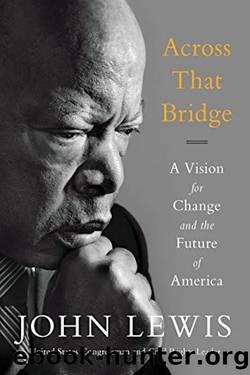Across That Bridge: Life Lessons and a Vision for Change by John Lewis

Author:John Lewis [Lewis, John]
Language: eng
Format: epub
Tags: 20th Century, Civil Rights, Ethics, History, Inspirational, Moral Philosophy, Motivational, Philosophy, Self-Help, United States
ISBN: 9781401303747
Google: jnwevMdZjwEC
Amazon: B007FSHN9G
Publisher: Hachette Books
Published: 2012-05-14T23:00:00+00:00
“I believe that unarmed truth and unconditional love will have the final word in reality. This is why right, temporarily defeated, is stronger than evil triumphant.”
—MARTIN LUTHER KING JR.
The idea of hundreds of black citizens taking to the streets and marching en masse through downtown Nashville or in Birmingham, Selma, or Washington D.C., was considered drastic because it challenged the muteness of our time and the society that had shut its mouth and turned its head in denial of the truth. Our souls were telling us something was wrong, but the status quo seemed formidable. The narrative of racial segregation had been confirmed for centuries by the skewed deductions of celebrated scientists, by the elegant verses of venerated poets, and the teachings of erudite educators. It had been eloquently defended by politicians and presidents and ferociously enforced by police. It had been sermonized and sanctified by ministers and upheld by the highest courts. Books were written, laws were constructed, and even the word of God was deemed to rationalize separation based on superficial differences. Certainly this mountain of material justified the need to aggressively segregate to avoid the foreboding consequences of race dilution.
The very idea of masses of black people marching on Washington actually struck fear in the hearts of thousands across America. But by taking these actions and confirming our adherence to peace regardless of any negative threats or admonitions raging around us, our insistence on action that was in keeping with the truth became a powerful mirror by which society could see itself. When we took action that belied everything many people thought was true, people began to see their fear for what it was: a mere shadow of reality, a specter that had no substance. And through the protests in the Deep South, where government-sponsored brutality enforced unjust laws, people watching on television could perceive the unseemly consequences of believing a set of distorted facts. They could see the logical conclusion of their irrational fears, and by witnessing the ugly result in others, they were more willing to admit they were wrong. They were more willing to change. By standing in our truth, we affirmed our value and asserted our inalienable right to exist. By marching en masse we were saying: We are not invisible. We are unmistakably real. We are not second-class citizens, but equal and open to all human experience. We do not accept or deserve disdain or abuse. We are human beings, not shuffling or bent, but erect, proud, and standing tall. We are citizens of this nation who have a right to be heard and have a right to fully participate. We were saying we would not be intimidated anymore. We are different, but we are equal.
From my earliest memories, I was fundamentally disturbed by the unbridled meanness of the world around me. Though I was not yet familiar with the words of the Declaration of Independence, I could feel in my bones that segregation was wrong, and I felt I had an obligation to change it.
Download
This site does not store any files on its server. We only index and link to content provided by other sites. Please contact the content providers to delete copyright contents if any and email us, we'll remove relevant links or contents immediately.
| African-American Studies | Asian American Studies |
| Disabled | Ethnic Studies |
| Hispanic American Studies | LGBT |
| Minority Studies | Native American Studies |
Cecilia; Or, Memoirs of an Heiress — Volume 1 by Fanny Burney(31324)
Cecilia; Or, Memoirs of an Heiress — Volume 3 by Fanny Burney(30928)
Cecilia; Or, Memoirs of an Heiress — Volume 2 by Fanny Burney(30885)
The Great Music City by Andrea Baker(21195)
We're Going to Need More Wine by Gabrielle Union(18066)
Bombshells: Glamour Girls of a Lifetime by Sullivan Steve(13101)
Pimp by Iceberg Slim(12923)
All the Missing Girls by Megan Miranda(12740)
Fifty Shades Freed by E L James(12443)
Norse Mythology by Gaiman Neil(11875)
Talking to Strangers by Malcolm Gladwell(11864)
Crazy Rich Asians by Kevin Kwan(8342)
Mindhunter: Inside the FBI's Elite Serial Crime Unit by John E. Douglas & Mark Olshaker(7829)
The Lost Art of Listening by Michael P. Nichols(6464)
Enlightenment Now: The Case for Reason, Science, Humanism, and Progress by Steven Pinker(6403)
Bad Blood by John Carreyrou(5762)
The Four Agreements by Don Miguel Ruiz(5502)
Weapons of Math Destruction by Cathy O'Neil(5031)
We Need to Talk by Celeste Headlee(4862)
